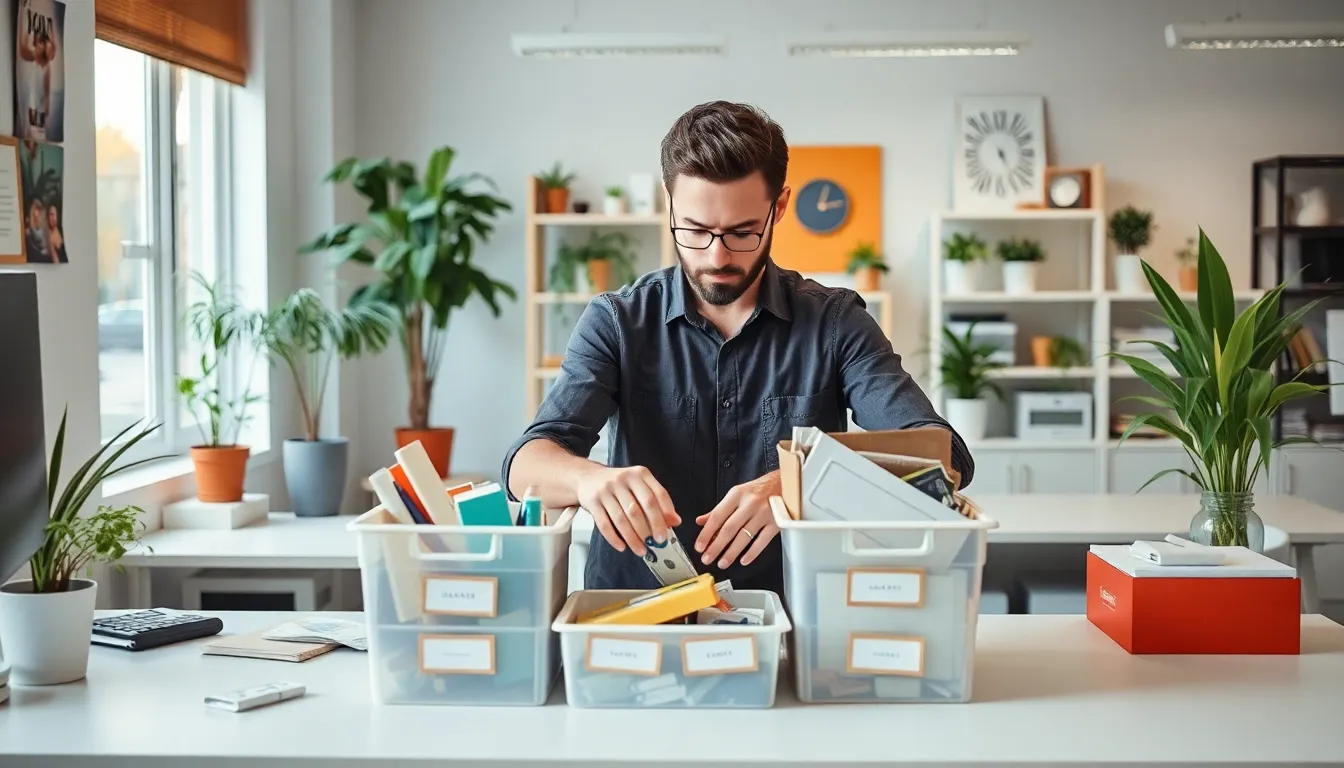A cluttered workspace can stifle creativity and productivity, leaving individuals feeling overwhelmed and distracted. In today’s fast-paced world, maintaining an organized environment is essential for achieving optimal focus and efficiency. By decluttering workspaces, people can reclaim their mental clarity and foster a more inspiring atmosphere.
Transforming a chaotic desk into a streamlined haven doesn’t have to be a daunting task. Simple strategies can make a significant difference, allowing for better organization and a clearer mind. Whether it’s clearing out old papers or optimizing digital files, taking the time to declutter can lead to greater satisfaction and improved performance in both personal and professional settings.
Table of Contents
ToggleImportance Of Decluttering Your Workspace
Decluttering a workspace significantly impacts overall productivity and focus. Maintaining an organized environment fosters mental clarity and enhances creativity.
Boosting Productivity
Boosting productivity occurs when individuals eliminate unnecessary items from their workspace. An organized area allows for efficient movement and quick access to essential tools and materials. Research shows that a tidy workspace can improve work output by as much as 20% (source: Princeton University). Employees report feeling less overwhelmed and more capable of focusing on tasks. Clear surfaces facilitate streamlined workflows and reduce time spent searching for lost items. Implementing systematic approaches to decluttering, like the 5S method, can systematically increase performance.
Enhancing Focus
Enhancing focus becomes achievable when distractions are minimized in a decluttered workspace. A clean environment allows for better concentration on tasks, leading to improved decision-making and creativity. According to studies, individuals can concentrate better and maintain their attention longer in a neat workspace. Clear desks and organized digital files help reduce cognitive overload, enabling individuals to engage more deeply with their work. By prioritizing decluttering, individuals can create a space that supports sustained attention and innovation.
Steps To Declutter Your Workspace

Decluttering a workspace involves a systematic approach. Following organized steps leads to a clearer, more efficient environment.
Assessing Your Current Situation
He or she should begin by evaluating the workspace condition. Identify areas of clutter and note items that disrupt focus or create chaos. Consider measuring the space; limited space can influence organization choices. Observe frequently used items versus rarely accessed tools. Knowing what’s essential aids in developing an effective decluttering strategy.
Sorting and Categorizing Items
He or she should sort items into specific categories.
- Keep: Select essential items necessary for daily tasks, such as computers and frequently used tools.
- Donate: Identify items in good condition that others can use, like books and office supplies.
- Recycle: Dispose of paper waste, outdated materials, and damaged items.
- Store: Use storage solutions like bins, folders, or drawer organizers for seldom-used items.
Organizing items into these categories fosters informed decision-making and minimizes future clutter risks. When sorting, aim for a balance between functionality and aesthetics to enhance workspace appeal.
Effective Decluttering Strategies
Implementing effective decluttering strategies transforms workspaces, enhancing productivity and focus. Below are key methods to achieve an organized environment.
Minimalist Approach
Adopting a minimalist approach simplifies workspace design. This method involves keeping only essential items, creating a cleaner and less overwhelming environment. By limiting decorative elements and unnecessary tools, individuals promote clarity. For example, using versatile organizers can help maintain a streamlined setup. Focusing on functionality rather than excess enhances not only aesthetics but also productivity. Studies show that minimalist workspaces can significantly reduce distractions and improve concentration.
Creating Designated Areas
Establishing designated areas optimizes workspace organization. Assign specific zones for different tasks, such as a reading corner, a tech station, or a project management area. These sections help delineate activities and keep associated materials in one location, minimizing clutter. For efficiency, label storage containers and files, ensuring everything is easily accessible. Additionally, maintaining a clear desk surface supports an orderly appearance and enhances workflow. Psychologically, knowing where items belong reduces anxiety and fosters a sense of control over the workspace.
Maintaining A Clutter-Free Workspace
Sustaining an organized workspace requires consistent effort and strategic habits. Implementing daily routines and regular assessments fosters a clutter-free environment.
Daily Decluttering Habits
Daily decluttering habits promote ongoing organization and efficiency.
- Clear desk surfaces. At the end of each workday, remove unnecessary items from the desk. This allows for a fresh start each morning.
- Organize paperwork. Sort through papers regularly, filing important documents and recycling or shredding those no longer needed.
- Manage digital files. Set aside time daily to delete irrelevant emails and organize digital files into clearly labeled folders.
- Limit desk items. Keep only essential tools on the desk, such as a computer, a notepad, and writing instruments, to minimize distractions.
- Update to-do lists. Review and adjust task lists daily to stay focused on priorities and remove completed tasks.
Regular Organizational Check-Ups
Regular organizational check-ups ensure workspace cleanliness and efficiency.
- Weekly assessments. Dedicate time each week to evaluate the workspace, checking for items needing attention or removal.
- Monthly deep cleans. Schedule monthly cleanings to tackle accumulated clutter, including corners, drawers, and shelves.
- Quarterly evaluations. Conduct a quarterly review of workspace effectiveness, making adjustments based on changing needs or tasks.
- Incorporate feedback. Solicit feedback from coworkers on shared spaces to identify clutter sources and improvement areas.
- Set seasonal goals. Establish goals each season to refresh the workspace, encouraging new systems and habits that sustain organization.
Decluttering a workspace is more than just tidying up; it’s about fostering an environment that enhances productivity and creativity. By implementing simple strategies and maintaining consistent habits, individuals can transform their work areas into inspiring spaces that promote focus.
A clean and organized workspace not only reduces distractions but also boosts efficiency and satisfaction. Regular assessments and mindful practices ensure that clutter doesn’t creep back in, allowing for sustained attention and innovative thinking.
Ultimately, the effort put into decluttering pays off in improved performance and a more enjoyable work experience. Creating a space that reflects clarity and purpose is a worthwhile investment for anyone looking to thrive in their personal and professional life.





